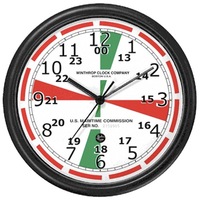2182 kHz
The radio frequency of 2182 kHz (kilohertz) is the international calling and distress frequency for maritime radiotelephone communications on the marine MF bands.[1]
Transmission modes
Transmissions on 2182 kHz commonly use single-sideband modulation (SSB) (upper sideband only), however amplitude modulation (AM) and some variants such as vestigial sideband are still in use, mainly by vessels with older equipment and by some coastal stations in an attempt to ensure compatibility with older and less sophisticated receivers.
Range
2182 kHz is analogous to channel 16 on the marine VHF band, but unlike VHF which is limited to ranges of about 20 to 50 nautical miles (40 to 90 km) depending on antenna height,[2] communications on 2182 kHz and nearby frequencies have a reliable range of around 50 to 150 nautical miles (90 to 280 km) during the day and 150 to 300 nautical miles (280 to 560 km) or sometimes more at night.[3] The reception range of even a well-equipped station can be severely limited in summer because of static caused by lightning.
Silence period

All stations using 2182 kHz were required to maintain a strictly enforced three-minute silence and listening period twice each hour, starting at h+00, h+30. This allowed any station with distress, urgent or safety traffic the best chance of being heard at that time, even if they were at some distance from other stations, operating on reduced battery power or perhaps reduced antenna efficiency, as for example from a dismasted vessel. As a visual aide-memoire, a typical clock in a ship's radio room would have these silence periods marked by shading the sectors from h+00 to h+03 and from h+30 to h+33 in green. Similar sectors were marked in red for what used to be the corresponding silence and listening period on 500 kHz between h+15 and h+18 and from h+45 to h+48.[4] These silence periods are no longer required as the introduction of GMDSS has produced alternative automatic watchkeeping systems and the 500 kHz band is no longer in use for maritime traffic.
Licensing
In order to operate a marine radio transmitter on 2182 kHz, the operator must hold a GMDSS General Operating Certificate for mandatory installations, a Long Range Certificate for voluntary ones, or other equivalent and recognised radio operator's qualifications. Both these certificates have a wider syllabus than those of the GMDSS Restricted Operators Course or the RYA Short Range Certificate that is necessary for marine VHF use. In practice, an unqualified operator would not be prosecuted for the use of either transmitter in what turns out to be a genuine distress situation.
Related distress frequencies
2182 kHz forms an essential part of the Global Maritime Distress Safety System (GMDSS). It has an associated DSC frequency at 2187.5 kHz. Other international distress frequencies, in use as of 2008, include:
- 121.5 MHz - civil aircraft emergency frequency
- 243 MHz - military aircraft emergency frequency
- 156.8 MHz - Marine VHF radio channel 16, short range maritime use
- 406 MHz / 406.1 MHz - Cospas-Sarsat international satellite-based search and rescue (SAR) distress alert detection and information distribution system
Discontinued frequencies
- 121.5 or 243 MHz locators. [5]
- Effective 01 August, 2013, the U. S. Coast Guard will terminate its radio guard of the international voice distress, safety and calling frequency 2182 kHz and the international digital selective calling (DSC) distress and safety frequency 2187.5 kHz. Additionally, marine information and weather broadcasts transmitted on 2670 kHz will terminate concurrently.[6]
See also
- Distress signal
- Marine VHF radio
- Mayday (distress signal)
- Channel 16 VHF
- Pan-pan
- Securite
- Global Maritime Distress Safety System
- 500 kHz
References
- ^ http://www.jproc.ca/rrp/distress.html Distress Communications, RADIO COMMUNICATIONS AND SIGNALS INTELLIGENCE IN THE CANADIAN NAVY
- ^ Bartlett, Tim (2009). Alison Noyce (ed.). VHF handbook. Southampton: RYA. pp. P. 10. ISBN 978-1-905104-03-1.
{{cite book}}:|pages=has extra text (help) - ^ "NATIONAL WEATHER SERVICE MARINE PRODUCTS VIA USCG MF VOICE". National Weather Service. NOAA. 6 Nov 2009. Retrieved 9 March 2010.
- ^ Proc, Jerry (5 April 2008). "DISTRESS COMMUNICATIONS". RADIO COMMUNICATIONS AND SIGNALS INTELLIGENCE IN THE CANADIAN NAVY. Retrieved 9 March 2010.
- ^ http://www.piersystem.com/go/doc/780/248571/ United States Coast Guard, Press Release
- ^ "COAST GUARD TERMINATION OF ITS 2 MHZ DISTRESS WATCHKEEPING SERVICE". U.S. Department of Homeland Security. Retrieved 16 July 2013.
